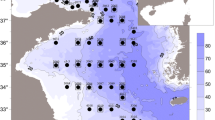Abstract
In 1994, 19 stations were sampled (2 replicates/station) with Young grabs in association with the EMAP-Estuaries Carolian Province Base Monitoring in Florida. A total of 295 unique benthic infauna taxa and 9647 individuals were identified and enumerated. Environmental data (bottom-water quality, sediment grain size, sediment metals, and organics) and benthic community data were analyzed using hierarchical agglomerative cluster analysis and ordination via nonmetric multidimensional scaling. Bray-Curtis similarities and Euclidean distance were used as the distance measures for biotic and abiotic data, respectively. Multivariate analyses were complemented by examining incremental contributions of benthic taxa to similarity values using a percentage similarity technique. A low-salinity site in a tributary to the St. Johns River had benthic communities uniquely different from those of moderate-to high-salinity sites. A diverse assemblage of polychaetes, gastropods, bivalves, amphipods, sipunculans, and phoronids was consistently associated with relatively unimpacted sites in the Indian River Lagoon. Infaunal community structure in the northern portion of the study area was influenced by the nearby Atlantic Ocean. Community shifts in association with latitudinal gradients and concentrations of sediment metals and organics were apparent. The nonparametric multivariate techniques used in this study were particularly effective at delineating and defining fine-scale community differences.
Similar content being viewed by others
References
Blake, J. A.: 1980, Proc. Biol. Soc. Wash. 93(4):947–962.
Blake, N. M.: 1983, “Systematics of Atlantic Spionidae (Annelida: Polychaeta) with special reference to deep water species”, Ph.D. Dissertation Boston University.
Bray, J. R. and Curtis, J. T.: 1957, Ecol. Monogr. 27, 325–349.
Clarke, K. R.: 1993, Aust. J. Ecol. 18, 117–143.
Clarke, K. R. and Ainsworth, M.: 1993, Mar. Ecol. Prog. Ser. 92, 205–219.
Clarke, K. R. and Warwick, R. M.: 1994, “Change in marine communities: an approach to statistical analysis and interpretation”, National Environment Research Council, UK. 144 pp.
Conover, W. J.: 1980, “Practical nonparametric statistics”. Wiley, New York, 493 pp.
Engle, V. D., Summers, J. K., Gaston, G. R.: 1994, Estuaries 17, 372–384.
Field, J. G., Clarke, K.R., Warwick, R. M.: 1982, Mar. Ecol. Prog. Ser. 8, 37–52.
Harper, D. E., McKinney, L. D., Salzer, R. R. and Case, R. J.: 1981, Contrib. Mar. Sci. 24, 53–79.
Hyland, J. L., Herrlinger, T. L., Snoots, T. R, Ringwood, A. H., Van Dolah, R. F., Hackney, C. T., Nelson, G. A., Rosen, J. S. and Kokkinakis, S. A.: 1996, “Environmental quality of estuaries of the Carolinian Province: 1994, Annual statistical summary for the 1994 EMAP-Estuaries Demonstration Project in the Carolinian Province”, NOAA Technical Memorandum NOS ORCA 97. NOAA/NOS, Office of Ocean Resources Conservation and Assessment, Silver Spring, MD. 102 pp.
Jongman, R. H. G., ter Braak, C. J. F., and Van Tongeren, O. F. R.: 1995, “Data analysis in community and landscape ecology”, Cambridge University Press.
Kaufman, L. and Rousseeuw, P. J.: 1990, “Finding groups in data: an introduction to cluster analysis”, Wiley, NY.
Kruskal, J. B.: 1964, Psychometrica 29, 1–27.
Long, E. R., McDonald, D. D., Smith, S. L., Calder, F. D.: 1995, Envionr. Manage. 19, 81–97.
Long, E. R. and Morgan, L. G.: 1990, “The potential for biological effects of sediment-sorbed contaminants tested in the National Status and Trends Program”, NOAA Technical Memorandum NOS OMA 52.
Ruppert, E. E. and Fox, R. S.: 1988, “Seashore animals of the southeast”, Univ. South Carolina Press, Columbia, SC, 429 pp.
Rosenberg, R.: 1977, J. Exp. Mar. Biol. Ecol. 26, 107–133.
SAS Institute: 1990, SAS/STAT users guide. SAS Institute, Cary, NC, 1341 pp.
ter Braak, C. J. F.: 1986, Ecology 67, 1167–1179.
U.S. Environmental Protection Agency (USEPA): 1994, “Environmental Monitoring and Assessment Program (EMAP): Laboratory methods manual — estuaries, Volume 1: Biological and physical analyses”, Office of Research and Development, Environmental Monitoring and Systems Laboratory, Cincinnati, OH.
Author information
Authors and Affiliations
Rights and permissions
About this article
Cite this article
McRae, G., Camp, D., Lyons, W. et al. Relating Benthic Infaunal Community Structure to Environmental Variables in Estuaries using Nonmetric Multidimensional Scaling and Similarity Analysis. Environ Monit Assess 51, 233–246 (1998). https://doi.org/10.1023/A:1005943504335
Issue Date:
DOI: https://doi.org/10.1023/A:1005943504335




